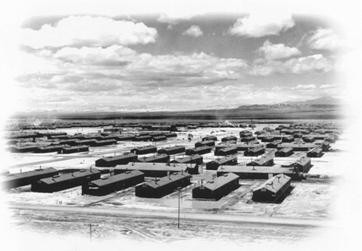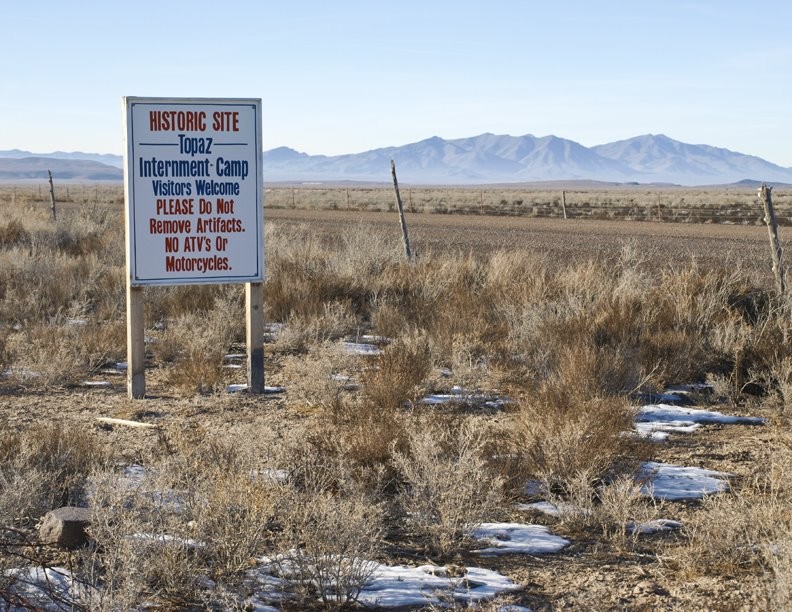Topaz (Central Utah Relocation Center)
Introduction
Text-to-speech Audio
Images

Today, many of the buildings and structures are gone. The few that remain are open to the public.

Backstory and Context
Text-to-speech Audio
Located within the Sevier Desert, the terrain of the former Topaz prison camp is a flat, desolate place
with temperatures ranging from 106°F to below zero. After the United States entry into World War II, farmers in the Delta knew that a labor shortage would result with all the young
men going to war. A proposal was made to bring Japanese Americans to work re-farming fields that had been abandoned in the 1920s. The federal government acquired 9,560 acres from one
individual and 8,840 acres from Millard County, for approximately $1 per acre.
Construction of Topaz began in June 1942, but the camp was not completed at the time it opened in September 1942. Construction was completed by the first 214 prisoners who had volunteered to help finish the camp. Topaz was designed to house 9,000 prisoners in forty-two blocks laid out in checkerboard fashion. Each residential block had twelve barracks. A fence consisting of four strands of barbed wire enclosed the entire 19,000 acres of the camp, which covered one-square mile (640 acres). Buildings were not sufficiently insulated for the extreme heat or cold at Topaz, and ill health was common.
James Hatsuki Wakasa, 63, was shot and killed by a guard at Topaz, for walking too
close to the fence on April 11, 1943. On the night of the shooting, Wakasa's body was quickly removed
from the scene by camp officials who also placed guards on alert, further alarming those confined at Topaz. The order was removed two days later. A large crowd of 1,700 gathered inside the camp to hold a
funeral for Wakasa.
Unrest over the killing of Wakasa led to massive work stoppages. In response, regulations were changed regarding the number of guards and use of weapons at Topaz. Camp administration also allowed people to go outside of the geographically remote camp. Entire blocks went on picnics out in the desert and used Antelope Springs as a camping spot, complete with tents and a swimming hole.
Topaz is noted for a large arts community. Chiura Obata, an instructor of art at the University of California at Berkeley, had organized an art school at the Tanforan Detention Center in northern California. He believed that art had the power to heal the human spirit. Obata joined with fellow prisoners Miné Okubo, Hisako Hibi, George Matsusaburo Hibi, and others to organize an art school at Topaz with 16 instructors. Over 600 students enrolled in 23 classes in graphic arts, anatomy, oil painting, and drafting.
Topaz had two elementary schools and one high school, which, despite few resources, provided sports, student clubs, a school newspaper, a yearbook, and dances. The two elementary schools enrolled 675 students and the high school enrolled 1,037, and were staffed by Caucasian and Japanese American teachers.After Topaz was closed in October 1945, the land was sold and most of the buildings were auctioned off and removed from the site. The pipes used to provide water to the camp were sold, and the trenches remain following their removal years ago. Many of the buildings from the camp are used as farm buildings throughout central Utah and an alert observer will see several of them during the drive to and from the camp site. One of the barracks has been moved to Delta, for the Topaz Museum.
In 1976, chapters of the Japanese American Citizens League in Salt Lake City purchased an acre of land at the former prison camp for a monument. In 1982, Delta High School teacher Jane Beckwith began studying Topaz with her journalism classes. People in Delta who had worked at Topaz or who had made friends there brought the class artifacts that they had saved since the war.
Several years later, Beckwith began a nonprofit group, the Topaz Museum Board, to preserve the Topaz site and create a museum. The Topaz Museum Board, a non-profit, volunteer organization, now owns 634 acres of the former Topaz camp. The Topaz Museum opened in 2015 at 55 West Main in Delta and is now open to the public, Monday through Saturday.
Sources
Huefner, Michael. Topaz. Densho Encyclopedia. . Accessed April 29, 2018. http://encyclopedia.densho.org/Topaz/#Literature_and_Art.
Digital Collections. Utah State University. . Accessed April 29, 2018. http://digital.lib.usu.edu.
Confinement and Ethnicity: An Overview of World War II Japanese American Relocation Sites. National Park Service. . Accessed April 29, 2018. https://www.nps.gov/parkhistory/online_books/anthropology74/ce12.htm.
Central Utah Relocation Center (Topaz) Site Delta, Utah. National Park Service. . Accessed April 29, 2018. https://www.nps.gov/nr/travel/asian_american_and_pacific_islander_heritage/central-utah-relocation-c.... Asian American and Pacific Islander Heritage
